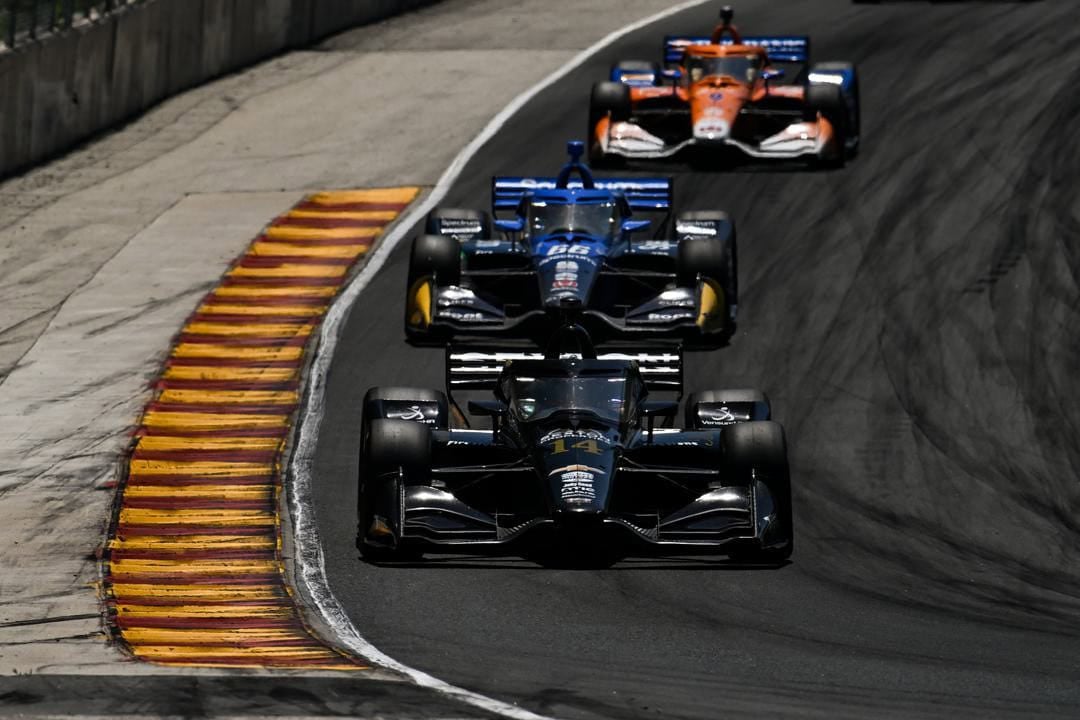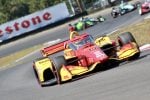With FOX’s recent partial acquisition of Penske Entertainment, speculation has run rampant about what that will hold for the future of IndyCar and its championship.
The domination of Alex Palou and Chip Ganassi Racing has led some to worry if a playoff format is coming to IndyCar racing, but with only 17 races, it would be nearly impossible to come up with an adequate format that would satisfy everybody and not completely upset those who think playoffs don’t belong in racing.
But let’s look at something else that might actually be a benefit for IndyCar racing. NASCAR had an in-season tournament in 2025 where drivers were pitted against each other in a single-elimination bracket with one goal: finish ahead of whoever their opponent was.
The grand prize? A million dollars.
Ty Gibbs beat out Ty Dillon at the recent Brickyard 400 at Indianapolis Motor Speedway, so let’s look at what that would look like for IndyCar.
Much like the NASCAR tournament, I decided to seed drivers based on average finishing position across three races, namely Long Beach, Barber Motorsports Park and the road course race at IMS in 16-, 24- and 26-driver brackets. Sorry, Jacob Abel, but you were the odd driver out for the final bracket.
For drivers who tied on average finishing position, the first tiebreaker was the best finish, followed by the second-best finish across those three races. Thankfully, nobody had identical finishes across all three races.
Because of the significance of the Indianapolis 500, I excluded that race from the in-season tournament and started the tournament at the following race in Detroit.
Here’s how the drivers ranked for their seedings:
- Alex Palou
- Scott McLaughlin
- Will Power
- Kyle Kirkwood
- Christian Lundgaard
- Pato O’Ward
- Scott Dixon
- Felix Rosenqvist
- Rinus VeeKay
- Alexander Rossi
- Marcus Armstrong
- Colton Herta
- Graham Rahal
- Nolan Siegel
- Josef Newgarden
- Santino Ferrucci
- Sting Ray Robb
- Louis Foster
- David Malukas
- Christian Rasmussen
- Kyffin Simpson
- Marcus Ericsson
- Conor Daly
- Robert Shwartzman
- Devlin DeFrancesco
- Callum Ilott
In a standard 16-driver tournament, the drivers would face off in 1 vs 16, 2 vs 15, etc., just like a normal tournament, with whoever finished higher advancing.
In the 24-driver tournament, drivers seeded ninth through 24th would face off against each other in Detroit to advance to the second race at Gateway against the top eight drivers who had a first-round bye, while only six drivers had first-round byes in the 26-driver tournament.
16-Driver Bracket
Using the above seeding format, Palou and Ferrucci would face off in Detroit. Thanks to Ferrucci finishing second and Palou finishing 25th due to Malukas punting him off, Ferrucci would advance to the second round.
McLaughlin and Newgarden faced off on the other side of the bracket and Newgarden advanced based on his ninth-place finishing position as McLaughlin finished 12th. Power finished fourth to advance over the 19th-placed Siegel, while race winner Kirkwood advanced past Rahal.
Fifth-seeded Lundgaard fell to Herta as eighth place was no match for third, while sixth-seeded O’Ward finished one position behind Armstrong, allowing the Kiwi to advance.
Dixon finished one position behind his adversary Rossi, allowing the 10th-seeded driver to advance while Rosenqvist advanced by default as his adversary VeeKay had an engine problem early on in Detroit.
For the next race at World Wide Technology Raceway, Ferrucci would face off against Rosenqvist, Herta would battle Kirkwood, Power and Armstrong would be opponents, leaving Rossi and Newgarden to be the final pairing.
Ferrucci would advance past Rosenqvist as the Connecticut native finished fifth ahead of the 16th-placed Swede. Kirkwood won at Gateway, putting him into the semi-finals by default over Herta.
Power was the first driver out at Gateway, allowing Armstrong to advance by default and Rossi finished 11th over Newgarden, who had the big accident with Foster.
The semi-finals for the 16-seed tournament had Ferrucci against Kirkwood and Armstrong against Rossi at Road America. Ferrucci finished third, just over a second ahead of Kirkwood. Armstrong finished fifth, four tenths of a second behind Kirkwood, while Rossi was 13th, so the final matchup in the 16-team bracket is Armstrong against Ferrucci at Mid-Ohio.
Armstrong’s race went well, finishing seventh just behind teammate Rosenqvist. Ferrucci on the other hand? Well…
So that means that Marcus Armstrong is your winner in a 16-team in-season tournament bracket.
24-Driver Bracket
For this bracket, the first eight seeds mentioned above have a first-round bye, so seeds 9-24 will face off in Detroit. Unfortunately, being the ninth-best seed doesn’t help VeeKay, as his engine failure in Detroit means that Shwartzman advances.
Rossi’s 10th-place finish ahead of Daly in 17th moves the California native on to the next round, while Armstrong’s sixth-place finish over Ericsson puts him through to Gateway. Simpson’s heroic fifth-place finish isn’t enough to put him past third-place finisher Herta, while Rahal in 20th squeaks by Rasmussen in 24th.
Malukas defeats Siegel while Newgarden finishes several places ahead of Foster to allow the Americans to advance. Meanwhile, Ferrucci’s second-place finish puts him ahead of Robb to set the field for the second round.
In the second round at Gateway, Palou faces off against Ferrucci again, with the result remaining the same; Ferrucci’s fifth-place finish is enough to knock eighth-place finisher Palou out of the tournament.
Shwartzman’s first IndyCar top-10 finish is enough to put the Israeli driver into the quarterfinals past Rosenqvist, while Lundgaard’s 14th-place finish puts the Danish racer into the next round instead of Herta, who finished 17th.
Kirkwood’s win at Gateway advances him past Rahal while Malukas’ bad final stint isn’t a worry as the Chicago native breezes by Power, who was the first car out of the race.
O’Ward’s second-place finish at Gateway puts him past Armstrong with ease, while Dixon’s fourth-place finish allows the 2008 Indianapolis 500 champion to move on. Last but not least, McLaughlin’s disastrous race at Gateway with an early retirement is barely enough to put him by Newgarden, who finished one spot lower than his teammate.
Moving on to Road America and Ferrucci advances past Shwartzman, who finished last. Kirkwood’s fourth-place finish puts him by Lundgaard with ease as the No. 7 Arrow McLaren Chevrolet finished 24th that day. Malukas’ early trip into the gravel trap wasn’t enough to stop the No. 4 A. J. Foyt Racing Chevrolet as he finished 10 positions higher than O’Ward, while Dixon’s ninth-place finish was three positions higher than his adversary, McLaughlin.
The semi-finals at Mid-Ohio were relatively straightforward. Ferrucci’s earlier documented incident was part of the reason he fell at Mid-Ohio, this time to Kirkwood, while Dixon’s win put him into the final against Kirkwood at Iowa Speedway’s race one.
Kirkwood’s accident at Iowa Speedway in race one means that Dixon was the winner of the 24-driver bracket.
As for the 26 driver bracket? Nothing changes in the big results except that Dixon had to advance past Ilott while Rosenqvist had to advance past DeFrancesco to create an identical bracket for the 24-driver bracket.
It may be a shock to see Palou not win the in-season tournament after his stellar start to the season. And while some may call foul on me not including the Indianapolis 500 in the tournament, know that Palou still wouldn’t have made the finals in each bracket thanks to Detroit.
And while championship-deciding playoffs don’t belong in motorsport, there are ways in which to allow a one-on-one style tournament into the sport without compromising the season’s championship integrity.
Why not give a tournament a go, then? Put a sponsor’s name on it, give out some money like the PeopleReady Challenge did a few years ago and let the drivers sort it out.
Christopher DeHarde has covered IndyCar racing and the Road to Indy for various outlets since 2014. In addition to open wheel racing, DeHarde has also covered IMSA and various short track racing events around Indiana. Originally from New Orleans, DeHarde moved to the Indianapolis area in 2017 to further pursue a career as a motorsports writer.




